#i feel like both these moments can seem antithetical to the core of their personalities
Explore tagged Tumblr posts
Text
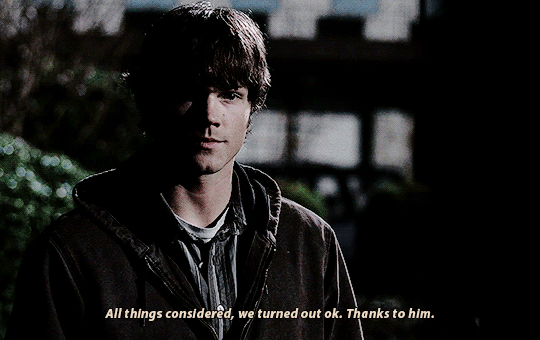
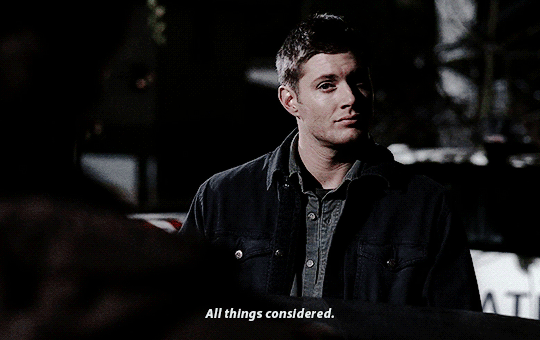

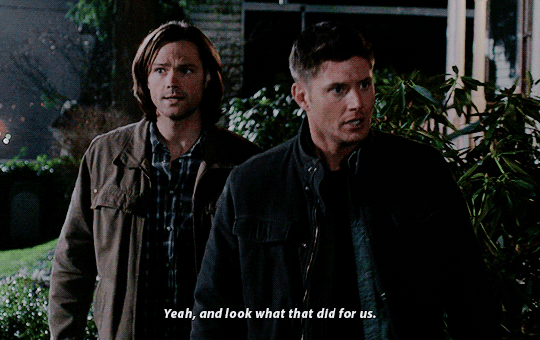
We're lucky we had Dad. 1.14 'Nightmare' | 8.18 'Freaks and Geeks'
#spnedit#corespnedit#samdeanedit#samedit#deanedit#*#*sdc#i feel like both these moments can seem antithetical to the core of their personalities#but they're really not#dean does tell sam at some point that sam and john 'were practically the same person'#and this doubt dean had about his father was there all along even though he would have denied it throughout the earlier seasons#like that resentment about being left behind#and sam's shift from 'hunting sucks bye' to 'actually...' happens quite early on in the show#and throughout the rest (that s8 retirement mishap nonwithstanding) sam usually stands by the fact that hunting is all there is for him#whereas dean shows resentment towards the way he was raised even though he does resign himself to the lifestyle#i am in particular thinking about that scene with mary where shes like 'he was a good dad' and dean is like 'yeah...'#(if i'm not mistaken; almost everything post season 8 is second hand knowledge for me)#(also as far as characterization goes i tend to take everything post-s5 with a grain of salt)#idk just some thoughts#family is hell#my father was an obsessed bastard#you two were practically the same person#i always feel a bit ridiculous sharing my thoughts because its been 17 years and everything that can be said probably HAS been said already#but this is just me rediscovering My Show under a new light and it's fun :)#why do i have to be some kind of hero
135 notes
·
View notes
Text
Neon Genesis Evangelion analysis chapter 20: Libido and Destrudo

Professor Fuyutsuki Metaphysical biology laboratory.
In attempting to understand the story of Neon Genesis Evangelion, the concept of a soul and how it plays into the wider narrative is an essential point where various story threads converge, but due to the idea of souls being abstract at best in our world, many glosses over this as an unexplainable Novum used as a set-piece. Yet, many symbolisms and set-pieces of this series require an understanding of the role of such Novum, thus we will touch on some of them here. (By Novums, I refer to Darko Suvin’s description of ���Scientifically plausible innovations used by SF narratives’).
In NGE, the concept of ‘Soul’ is explained to lie under the branch of ‘metaphysical biology’ and was Fuyutsuki's field of academic studies. It is mentioned only in passing when we get a glimpse of his past thus making it easy to gloss over, but it is an integral part of the world-building. Side note, in our world, ‘metaphysical biology’ is a branch of the ‘philosophical biology’ but in the world of Evangelion, it is used to explain how the lived experience and emotions of a person come to take form and is a field of scientific study.
In simpler words, it is a belief that the thoughts and feelings of an individual can take material form through the use of ‘certain’ kinds of energy. It is how we can explain the maintaining of an individual’s body in a certain shape using AT field (In a shape that is imagined by the soul [ego]).

Without the AT field, there is no form
All living things consist of its soul and have a body to ‘contain’ it, this soul originating from the room of Guf. In Lilin’s case, their souls have merged with LCL and it is the AT field that keeps the fluid in the shape required to function as a living thing. This is why in the absence of an AT field (such as when it is neutralized by the Anti AT filed waves), the bodies lose its form and revert into LCL as we see during the End of Evangelion.

What does pattern Blue mean?
Unlike the Lilins, Adam, Lilith, and the angels' bodies are not made up of the LCL but what is referred to as the wave-particle matters, allowing their bodies to exists even in the absence of a soul. This is used to explain how the White giant in the central dogma (Lilith) was able to maintain its form when the soul was split and placed in unit – 00 and Rei, and how she changed into a gigantic Rei once the Soul was returned.
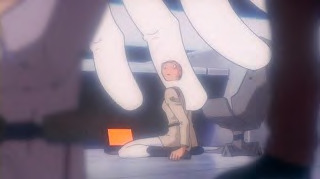
Not solid, nor liquid, nor gas
wave-particle matters, according to Ritsuko, refers to a unique matter that exists as both wave and particle materializing at the same moment, this is different in our world where the wave-particle duality problem still exists and we can rightfully believe that Anno simply burrowed the term without the complexities of it. Yet it is still useful to think of this matter as a form of “light” and it is best exemplifies when we see the Rei + Adam + Lilith’s (Rei + AL) hand passing through Maya without any harm, and due to it not requiring an active AT-field to maintain its shape, we can observe the Evas and Rei + AL not reverting to LCL during the End of Evangelion's "Come Sweet Death" scene.
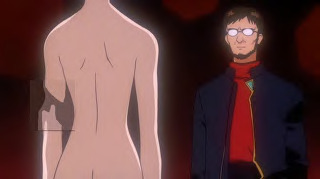
Rei and Humans are biological different
In chapter 10, I have posited that Lilith’s DNA is present in Rei and presented the hair of Unit – 01 and Rei being the same color as a piece of evidence, I can now state this more accurately and say that part of Lilith’s wave-particle material likely has entered Rei during her body construction process. That is the reason why the cloned bodies of Rei we see in episode 23 were able to maintain their form in the absence of a soul inside them. We will be touching upon this topic again in the future.

Libido and Destrudo
Now let us talk about Libido and Destrudo. In our world, these are terms used in philosophy and psychology and tends to refer to a similar concept (refer to Herbert Marcuse's "Eros and civilization" but also many of Freud's works). However, in the world of Evangelion, they are both “Quantifiable mental energy” and are intrinsically linked to the role of souls in producing AT field.
Since the souls’ are vulnerable to having its existence interfered by another soul, resulting in it being forcefully re-shaped, AT fields are set up to maintain physical form and prevent such mishaps. However, an AT field that is too strong can also have harmful effects.
Simply put, there is an amount of AT-field required by each living thing to maintain their selfhood, this requiring a certain amount of energy to maintain this territory of self. This energy is the combination of two types of energy that are Libido and Destrudo.

Libido: the will to life
Libido is similar in concept as eros; a form of mental energy held by all living things. Destrudo is the necessary precondition for the existence of the creation of something from nothing. While Libido is often conceptualized with sexual urges, its original scope is much larger, enveloping all forms of productive energies that includes love. Libido is sub-constituted by the instincts of Id and Ego and is represented in the Evangelion series as AT-field. Libido = AT field.
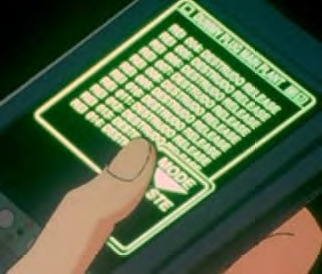
REI 00N: DESTRUDO RELEASE

The result
On the surface level, Destrudo is the antithetical concept to Libido and is more often referred to as Thanatos in the Freudian concept. It can be described as the “Attraction to death”, and “Instinct to destroy”. While it might seem like a negative concept, it is integral mental energy that works alongside Libido for the continued existence of all living things. When Libido stimulates the stress for the “continued existence” of living things, Destrudo (Thanatos) is also released to maintain the delicate balance necessary for a healthy existence and mental state. In the Evangelion series, this is referred to as the Anti-AT field. We can see that Destrudo = Anti-AT field hypothesis being supported in episode 23 when Ritsuko releases destrudo waves as she initiates the breakdown of Cloned Reis’ bodies.
Let us not forget that Libido and Destrudo are concepts used to explain the existence of a soul in Evangelion. One narrative conflict in Evangelion lies in the choice between the maintenance of the individualized and atomized existence or the achievement of the unified being like those of Angels through Instrumentalization; they are fighting over the size and number of Lilins’ ego (subjecthood) that should be in existence, the existence of souls is a question that supersedes all of this viewpoints. It is the soul that is used for the creation of a connection between the pilot and their Evas. What supports this statement is the production of Libido and Destrudo when they are piloting it, and the strength and balance of this energy are what is being measured during the synchronization test. We can observe this in Asuka where her ability to pilot Unit - 02 correlates with her will to live throughout the series, and we can also say that the role of the dummy plug is the imitation of the mental (thus of Libido and Destrudo) patterns of a specific individual.

Ritsuko: Salvage start!
Maya: Roger, Sending the first wave
Maya: Eva received the waves. No rejection sequence detected

Continue with the second and third wave
No rejection was detected. No Destrudo observed.
We can see these two energies being used in episode 20 when Shinji's soul was absorbed into the Unit – 01’s core and his body reverting into LCL. The salvage operation that was performed to retrieve him explicitly showed us the graph of Libido and Destrudo meter reflected on the operators' screens. Let me pose you a question here, to bring back Shinji from his current formless shape, which of the two energy should be used to bring him back? The answer is Libido, the AT field energy. It is most likely that they inserted Libido energy into the entry plug and this can be seen in the erotic sequence that we observe from Shinji's perspective.

There are two instances of the salvage operation that we are aware of. First is Yui’s case, second Shinji’s. Both instances failed, however, this was not due to the hypothesis of the Libido-AT field being inaccurate. It is because the individual did not wish to return to individual selfhood. Although for Shinji, he managed to wake up on is own accord afterward, foreshadowing his return from the primordial ocean at the end of Evangelion.

The Shinji’s Libido is depicted often and in focus throughout the series. It starts in episode 10 with Shinji’s innocent reaction to Asuka’s filtration, the young boy’s fantasy during the Onsen sequence while overhearing Misato and Asuka’s conversation, and the touching of Rei’s breast. All these instances gave Shinji a boost in his Libido level and this can be linked to his gradual increase of Synchronisation rate. This observation can also be used to help explain the reason why fourteen-year-olds are chosen to be pilots.

The hot-blooded face of Shinji
When we look at Shinji’s face during the fight with Zeruel, at the moment his synchronization rate reached 400%, we can see the effects of Destrudo energy manifesting. In this sequence, we see Shinji smiling with what can only be explained as ecstasy that is too far off from his usual self. The high synchronization rate can be explained with the rise of the Destrudo level here. Destrudo being released due to Shinji’s desire for the destruction of Zeruel means that there is also high Libido that presents to balance out the destrudo level.

Shinji is not okay in this scene.

The metaphysical materialization of Destrudo; circa start of instrumentalization


And the result….?
The concept of Libido and Destrudo plays an integral role in our understanding of the End of Evangelion as well. At the beginning of the movie, we see Shinji having set up a strong barrier against other people (AT field), which means that his current stress for living, the Libido level is at an incredibly and irregularly high level. The sequence where he is seen masturbating to Asuka’s breast shows this dichotomy between the desire for sex against the desire to shield self from others (both being the manifestation of Libido) and it makes the viewing experience extremely uncomfortable.
Later, during the beginning phase of the instrumentalization, as the AT fields are being eroded by the Anti-AT field waves, we observe scenes that epitomizes the destructive instincts of Destrudo. The scene of Shinji choking Asuka is overlayed with the sinister smile during his battle against Zeruel and is followed by multiple bizarre and violent, yet childlike drawings (Libido and Destrudo often reach their peak during childhood and this can be observed in their drawings as well).

Unit – 01 with the Dummy plug choking Unit – 03 (Bardiel)
I will wrap up the discussion on the Dummy system here as well. The requirement for the activation of the Evangelions is the Libido and Destrudo energies, which means that the Dummy system that only imitates the mental patterns of Libido and Destrudo production does not have emotions nor logic. Therefore we can observe the animal-like fighting style of the Dummy system against Bardiel; this shows that even if the system is based on Rei's mental patterns, it has no logic nor emotions and fights on an instinctual level. Thus the dummy system is not a perfect representation of the original.
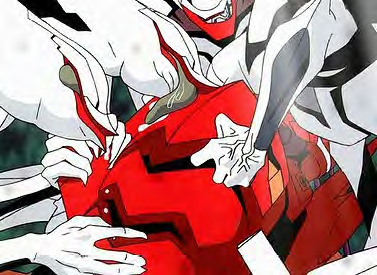
Skipping over the details here
The progressed version of the Dummy system, one based on Kaworu and implanted into the mass production models takes this further and shows us both of the actions lead by Libido and Destrudo, this was shown in graphic and explicit detail that the movie's R-18 rating allowed. The scene that caused quite a stir, when the mass production models are sexually petting and licking Unit – 02 was led by Libido. Many chucked it up to and accused Anno being a pervert, however, I see this as an important scene that serves mainly to further explain the role of these two energies released by the dummy system. There is a question often brought up regarding the grotesque design of the Mass production models, and the answer is that it was done to visually depict the unfiltered, and uncontrolled desire for Lust (Libido) and destruction (Destrudo).
The desire for life and love and the desire for destruction and instrumentalization are hidden set pieces of this series and are easy to overlook and ignore. But we must not forget that it is depicted in canon and plays a significant role in the ongoing narrative, yet there tends to be very little discussion of this set piece. I hope that this chapter has been useful in aiding your understanding of the series further.
This chapter ends the section on the organizations and angels. Starting from next, we will dive into the discussion of each character and the roles they play in the narrative. The first batter is Kaji Ryoji.
TBC Chapter 21: Kaji Ryoji Lies and Silence
#Neon genesis evangelion#Evangelion#Eva#End of evangelion#Nge#Nagisa Kaworu#Lilith#Sci-fi#Ikari Shinji#Soryu Asuka Langley#asuka#Ayanami Rei#rei#Anno Hideaki#Katsuragi Misato#Anime#Analysis#Review#Kaji Ryoji
76 notes
·
View notes
Text
My goal for 2017 was to beat 50 games. Unless I finish anything else over the next couple of days (doubtful), my actual number is 46, which I’m still quite happy with.
Some of these were games I’d already started before 2017 (e.g. Kingdom Hearts II Final Mix, which I played most of throughout 2016 and finished in January). Many were small indie games, some only a few minutes long (e.g. Secrets Agent, which is maybe ten minutes). Some were more middling offerings (e.g. Aerannis, which I clocked 8 hours in), and some were the big, exciting games that 2017 is coming to be known for. There are also many games I played significant amounts of this year that do not count towards the above number because I haven’t finished them (like World of Final Fantasy, which I got for Christmas last year but still haven’t finished despite returning to it every couple of months).
DLC also makes calculating that number a little more difficult, especially the way DLC is more frequently being handled. Final Fantasy XV was released towards the end of 2016, and I ‘finished’ it, at the latest, in early 2017. But that was only the main story. There are a few DLC episodes out now (I’ve played two of them) as well as story improvements and a bigger DLC campaign. I could finish those, but the developers have stated that there’s going to be even more DLC in 2018, which is bizarre for a game that’s a year old, but less bizarre now than it used to be. Breath of the Wild’s DLC took a while to be released (also not part of the above number for that reason), and Xenoblade Chronicles 2 looks to be releasing DLC until at least autumn 2018. For a person who likes his games to be one and done, this trend is frustrating. Companies want their games to last longer, to remain fresh in our minds so we can give them more money. This is largely antithetical to the pursuit of games as an art form, and it’s also annoying. I like finishing things. Not knowing when the DLC is gonna stop robs me of the satisfaction of saying a game is complete, of adding it to my end of year count.
The best game I played that came out this year is almost certainly Persona 5. For all its failings, it is a solid, polished RPG that at least tries to tackle social inequality. Most of the games I really loved that I played this year are actually from years prior, however. I’m glad I finished Shin Megami Tensei: Nocturne this year, because it made me appreciate Persona 5 even more.
I dove into two older series I’ve always loved this year. One is Breath of Fire. The only BoF game I’d completed before was IV, but I’d played a lot of III as well. I went through I, II, and III in 2017, finishing the entire main series (Dragon Quarter notwithstanding). IV remains my favourite in the series, but all the games are oozing with charm and personality. Very few games manage to feel as original as BoF, even though they are, at the series’ core, standard JRPGs.
The other series I dove into is Xenosaga. Last year I replayed Xenosaga Episode I. This year I replayed Episode II and then finally, finally finished Episode III. I’ve long considered I to be one of my favourite games of all time, but III is a masterpiece that manages to surpass it. Its only faults are in the spaces where you can tell the series was supposed to have more titles in it before it was cancelled prematurely, and maybe one annoying sidequest. And the fanservice. Otherwise it is nearly perfect, and ends the series beautifully. The KOS-MOS showdown near the end has got to be one of my favourite gaming moments ever.
On the indie side of things I loved Read Only Memories, the queer sci-fi I’ve always wanted; Curtain, an artful representation of abusive relationships; Even the Ocean, a mindful environmental fable with impeccable mechanics; We Know the Devil, one of the most poetically written visual novels I’ve ever played; Lieve Oma, a touching tribute to memory; and Strange Flesh, a bizarre gay sex beat-em-up. I also loved Longest Night and Longest Night: Lost Constellation, two free side games for Night in the Woods, which is definitely on my list of games to play for 2018. If you were curious but not sold on NitW, play those two games and they will sell you on it.
Which brings me to the games I’m looking forward to playing (and/or beating) in 2018. Night in the Woods is up there, and they just released a fancy new expanded edition, so it seems like the perfect time to finally jump in. The new Steven Universe game, Save the Light, is out now as well, and given how good Attack the Light is, I would be a fool not to play this one. Blue Reflection also has me curious, as a Persona-lite game with magical girls, even though it’s gotta be a fanservicey mess. And I can’t forget about Tacoma for more queer sci-fi.
I plan on doing a deeper dive into the Shin Megami Tensei series as well. I’m already playing Persona Q and Tokyo Mirage Sessions, and 2018 is the year I finish both of them. Once those are off my plate, I can jump into Digital Devil Saga, which was gifted to me this year, and then more of the core series, maybe starting with the first Shin Megami Tensei on iOS. Who knows when SMT V on the Switch will be out, but I want to burn through more of the series before it gets here.
I’m also playing and plan on finishing Atelier Sophie (might check out more Atelier after), Beat Sneak Bandit (and I still have Bumpy Road to play to finish my Simogo backlog before they announce their new game), Bravely Second (the devs keep hinting at a Bravely Third), Fire Emblem Fates (it’s just Revelations left, and I wanna beat it before getting to Echoes which was a Christmas gift), Valkyria Chronicles II (stoked for VC 4!), and as I’ve already mentioned, World of FF and Xenoblade Chronicles 2.
In my backlog to be hopefully played this year are Horizon Zero Dawn (I’ve been wanting to play this since it was announced!), I Am Setsuna, Kentucky Route Zero, Lost Dimension, Mass Effect 3, Muramasa, Nights of Azure, Owlboy, and lots, lots more.
Some games coming out in 2018 I’m looking forward to are Digimon Story Cyber Sleuth: Hacker’s Memory, Radiant Historia Perfect Chronology, Alliance Alive, 13 Sentinels: Aegis Rim, Ooblets, Heart Forth Alicia, The Last of Us 2, and Kingdom Hearts III (not sure about 2018 for those last two though).
Shout-out to Splatoon 2, the only multiplayer game to keep me playing even though it doesn’t satisfy my craving for endings because it never fucking ends. It’s just that good.
I hope 2018 is relatively slow for new game releases, so I can do some much needed catch-up. 2018 also looks like it could be a good year for my writing career, as long as I focus enough, so I’m only planning on beating a modest 40 games. If you’ve read this far, feel free to chat me up about what games you’ve played this year. As evidenced here, I can go on forever about video games.
#quiet reminder at the end of this wall of text that video games would improve drastically under socialism#removing the profit incentive will end predatory DLC practices and open up game dev to those who can't afford it#people only making games for money will fuck off and people making them for passion will get the fuck to work#anyways thanks for reading#this is me signing out of 2017#ugh okay i keep thinking about this and remembering more games i could have talked about#not gonna add anything else though or it'll never end#just know that there are so many games#so many...
2 notes
·
View notes
Text
The end.
week 13: Jay David Bolter and Richard Grusin, “Remediation”
Maghada Kingdom, Northern India. Somewhere around 2500 years ago:

I feel you Sha’
All beautiful things must end, and so also my smart-ass blogposts have to.
SAD
But I don’t know maybe you can pool some kind of financial resources and grant me a salary to write you reviews on stuff. It’d be cool, and I’d be constantly on strike to try and negotiate a better wage because

But anyways.
Before we start this last ride about digital media, I have a kind message addressed to my dear friends Bolter & Grusin

No for real guys. Don’t get me wrong here, your paper is great and you sound like chill dudes, but
DUDE
your points are SIMPLE, and we’re all grown ups with an education. You DO NOT have to state and re-state the obvious and make multiple and equally obvious examples
LIKE, WE GET IT
Instead NO, it takes these two little bitches something like
THIRTY PAGES
to get to the main point of the essay.

But oi, maybe I get it. Maybe you were writing for some whiny-ass professor/boss who gave you a nasty word count, or maybe editorial draconian policies by the journal forced you to do this. Boh. I don’t know. Don’t wanna antagonize her but reading you kids was a tour de force.
BUT LET US NOT GET DISTRACTED LIKE WE DO ALL THE FUCKING TIME
Bolter and Grusin’s article does something quite simple: it attempts to set theoretical lineaments to the three concepts of immediacy, hypermediacy, and remediation. Very cool.
The ‘core’ of the whole essay is something pretty much like this:
Our [sick-ass neurotic] Western culture is fixated on both immediacy and hypermediation. To achieve the first, we [very reasonably and not at all pervertedly] paradoxycally construct hypermediated environments. But we do also the reverse [again great reasoning abilities here]: in going all-in for hypermediacy we tend to rely on seemingly immediate devices. All this media push-and-pull is fucking bipolar implies a logic of remediation, in which the emergence of every new media generates reciprocal ‘borrowings’ and incorporations between the new and the old.
Now Bolter. Grusin.
DOES MY PARAGRAPH LOOK THIRTY FUCKING PAGES LONG?
B & G: No
GOOD. THEN WHY THE HELL YOURS DOES?

Fucking academics, man. They drive me crazy.
So the point is that this logic of remediation is based upon the mutual dependence of contradictiory determinations (the fact that immediacy depends on hypermediacy). And well, what is it if not another episode of my highly acclaimed sit-com series
“What famous philosopher is featured in this paper?”
Our guest star today is a boy you’ve already seen in this post.

Oh yeah baby, keep those antithetical determinations struggling with each other!
And so yeah, “Immediacy depends upon hypermediacy,” and very much like an original synthesis that transcends thesis and antithesis,
“the desire for immediacy leads to a process of appropriation and critique by which digital media reshape or ‘remediate’ one another and their analog predecessors” (314).
From this point, B. & G. write words upon words to disscuss the concepts of immediacy and hypermediacy, constructing what they define a “genealogy” of the two concepts. But they means this in a very specific way. Is another guest star of “What famous philosopher is featured in this paper” coming to join us?
OF COURSE
but surprises don’t end here, because
IT’S A RETURN!

Oh yeah, your favorite bald philosophical sex symbol is back to tell you that by saying “genealogy” he means
“an examination of descent” which “permits the discovery, under the unique aspect of a trait or a concept, of the myriad events through which—thanks to which, against which—they were formed” (qtd. in 315).
Therefore Bolter and Grusin investigate the way in which these two concepts have been shaped by cultural discourse over history. Which is all fun and leisure, but not really that important to us.
One thing I did want to talk about tho is the political aspect of immediacy. So let me get this straight. When discussing VR, B&G write:
“All these enthusiasts promise us perceptual immediacy, experience without mediation. They expect virtual reality to diminish and ultimately to deny the mediating presence of the computer and its interface” (317).
Now, you have been blessed enough to encounter some Marxism in your life, you might be reminded of the crucial concept of ideology. An ideology is a set of beliefs shared by members of a society – or imposed upon them – that naturalizes artificial relationships and norms inside that community. The thing about ideologies, though, is that they are not immediately visible. They are, to borrow from B&G, transparent, because they are designed to be invisible and to provide a sense of immediacy in social dialectic. Moreover, the stronger an ideology is – the more rooted it is in culture – the less visible it is. We could say, for instance, that Mark Fisher’s concept of Capitalist Realism works as a very transparent ideology.

Rest in peace, comrade.
But going even deeper, it seems to me that this whole transparency thing is very totalitarian. Like VR is kind of totalitarian, because it seeks complete and utter control over your body and senses. Totalitarianism is like a transparent interface. It is a form of cultural VR. Or rather, ideology is a form of virtual reality.

And, oi, B&G make it clear enough that this works also when individuals have personal freedom. Sure, they’re talking about digital media, but still look at what they write:
“For if immediacy is promoted by removing the programmer/creator from the image, immediacy can also be promoted by involving the viewer more intimately in the image” (324).
That’s DEEP bruh.
Now let’s move on. So immediacy is essentially the dominant regime for much of the history of Western culture. Or at least ever since the Renaissance. It is the dream of being able to produce objects that trick us into believing that what we see is real. Fine.
Hypermediacy is sort of like its nemesis. It is the cultural regime of fragmentation, indeterminacy, multiplicity, heterogeneity and pretty much also of deliberate and explicit artificiality.
IT’S VERY POSTMODERN
VERY META-
It’s culture that is aware of its mediated nature, and breaks that suspension of disbelief stuff that makes you care for characters created by someone else.
youtube
See this at work in one of the greatest moments of digital media history.
Bolt ’n’ Grus have a lot of superfluous stuff to say about it, but unfortunately for them I am very postmodern too and my attention spans are short and so I’ll jump to remediation.
Remediation is B&S’s killer application. All their money is on this nice idea. The idea is that one of the defining characteristic of contemporary digital media – or rather, a phenomenon sparked by the emergence of them – is the fact that media represents other media in them. This, they say, can happen in four different modes.
1. Transparency: digital media highlights and re-presents an older media without any trace of irony or critique. This is like when you go search for that old album you really like on Apple Music. The platform does not ‘comment on’ the music. It just allows you to experience it by reproducing the older vynil/CD medium.

2. Emphasis on difference: digital media underlines and renders particularly evident the difference between itself and older media. Kinda like an improvement of older media through digital tools. This encompasses all the ‘expanded’ stuff you can get. Like library guides on our our library’s website. They are text-based like a physical library guide would, but they also have nice little video tutorials which improve them. Through the digital.
3. Refashoning: an ‘aggressive’ form of remediation that tries to refashion older media entirely while still signaling its presence and therefore retaining a sense of multiplicity. Here artificiality is explicit and discontinuity is visible. It is kind of like a new media collage. Something like this, perhaps:
youtube
4. Absorption and incorporation: the fourth and final mode is one in which discontinuity is minimized, because a media has entirely absorbed one or more characteristics of another one. Thus, we sort of come full circle, in the sense that absorption is superficially quite similar to transparency. Note that absorption works in both directions. Therefore you have it both in film through CGI and in videogames through cinematic cutscenes.
Our reading for this article ended with Bolter and Grusin saying that at the present moment (which for them is 1996, but non importa) all mediation is remediation, in the sense that “each medium or constellation of media […] responds to, redeploys, competes with, and reforms other media” (345). Which is also a way to offer a new connotation to the concept of media environment.
Now, sadly
WE ARE DONE.
It’s been a hell of a ride. I mean a hell. But also a ride. So we’re kind of even. It is time for me to bid you farewell; remind you to have protected sex always; assure you that, no, you won’t have panick attacks for the rest of your life (it’s the oppressive and ultra-competitive educational system’s fault); and re-assure you that, eventually, the dialectic of history will complete its cycle, unveil the inherent contradictions of capitalist societies, and prepare for the advent of a millenary communist civilization.

This come from Amazon, lol
Everything will turn out well. We will be fine. One day Donald Trump, Matteo Salvini, Boris Johnson, Marine Le Pen, Vladimir Putin, and Jair Bolsonaro will all rot in hell. We will probably have to deal with the catastrophic consequences of climate change brought about by capitalism but we’ll come out of this with a stronger, more inclusive, and more just society. Our dreams will come true and we’ll all become badass human beings who will be pillars of a reformed, humane society.
Enjoy the ride!
Today’s culture is a celebration of our struggles to become great and revolutionary individuals. Enjoy that too.
Coldplay - Lost!
youtube
William Blake, The Angel of Revelation (1805)

Adieu!
Image Sources: GIPHY, metmuseum.org, thenewpolis.com, micciacorta.it, amazon.com
1 note
·
View note
Text
The Best Films of 2018, Part IV
Scroll down for Parts I, II, and III. VERY GOOD MOVIES THAT STILL AREN’T TECHNICALLY GREAT--SEE, I LIED, NEW CATEGORY, WHICH REALLY SAYS SOMETHING ABOUT THIS TIER IN 2018 AND MAYBE HINTS THAT THERE WEREN’T MANY MOVIES THAT I GENUINELY LOVED
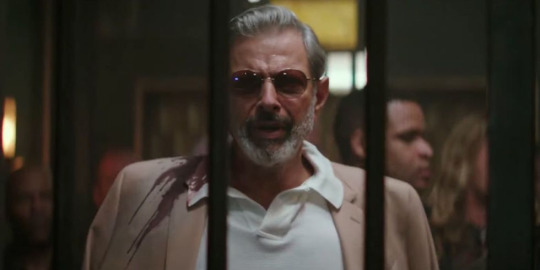
44. Hotel Artemis (Drew Pearce)- It should be illegal to watch this movie before midnight because it is an exploitation flick to its core. Is it a problem that it's shaped like a triangle, that it starts wrapping up its answers the minute we understand what the questions were? Yes. Is that a problem that Jeff Goldblum, playing the Wolf King, wearing a double-breasted camel's hair coat like a shawl, can't fix? No.
43. Sicario: Day of the Soldado (Stefano Sollima)- Considering how much I liked Sicario, I'm impressed by how close its sequel came to its chilly hardness. Strangely enough, the craft suffers more from the absence of Jóhann Jóhannsson than it does from the absence of Denis Villeneuve. Aside from a lull at the two-thirds mark and the pulling of exactly one punch, this entry feels as vital and astute as the last one.
Which means the real auteur must be Taylor Sheridan. His script mimics the structure of the original while twisting its characters just askew enough to breathe new life into the material. His screenplays just sort of unfold in a way that I find organic--it's hard to even say what the conflict is until halfway through most of the time. And if he wants to write five more of these, I'll gladly take them.
42. The Other Side of the Wind (Orson Welles)- Like almost anyone else, I'm grateful that The Other Side of the Wind exists at all. The fact that it's so more personal and experimental than I expected is a bonus. It's kind of a mess until it congeals at the drive-in, but every choice still seems labored over. (The claustrophobic nature of the party versus the wide open spaces of the film-within-the-film, for example.) Nonetheless, it's hard to go to bat for a movie whose backstory is more captivating than the final product.
41. The Mule (Clint Eastwood)- Besides the breezy glide of the pacing, the performances stand out. Eastwood's is the type that we haven't seen from him in a while. He smiles a lot. He sings and dances and flirts. He's generally carefree and loopy. And he's contrasted with* a nervy Bradley Cooper in one of those humongous-star-taking-the-back-seat performances, sprinkling charisma the way Sean Connery did in The Untouchables.
But there is no elegance at all. Besides Chekhov's cough and the cheesy elbowing of "If only somebody had $25,000 to save the VFW Hall," we get the messy racial politics of Eastwood once again. Whereas Gran Torino worked for me because it's aware of its own racism, this one thinks that it's doing some good. The subtext is that an old White man would never catch trouble from police, but the text is a Hispanic man getting pulled over and nearly pissing himself for laughs. Hard to argue this isn't a fun time at the movies though, despite the fact that it's almost entirely about regret.
40. If Beale Street Could Talk (Barry Jenkins)- Too theatrical and outre for my taste, but it's easy to get lost in its cosmetic pleasures: the lush colors, the lavish costumes, the immaculate close-ups, the best score of the year. I liked it, especially the Brian Tyree Henry tangent, but as the movie is swooning over itself, it's easy to catch yourself thinking, "What is this even about?"
39. Can You Ever Forgive Me? (Marielle Heller)- Can You Ever Forgive Me? hits every beat you would expect from an "in over her head" crime movie, but the time that the film dedicates to the central relationship creates a rare intimacy. If you stopwatched it, I imagine the majority of the film would be McCarthy and Grant talking to each other. That focus, along with a resistance to smoothing over the characters' rougher edges, elevates a kind of boilerplate story.
38. Blockers (Kay Cannon)- Even if the ending is kind of exhausting, desperate to give each character his or her moment, this is hilarious. Not so much in the setpieces showcased in the commercials but frequently in an expression or line reading. The Blu-Ray has a line-o-rama gag reel that is funnier than some entire movies. It's pretty progressive and fair in its portrayal of young female sexuality too.
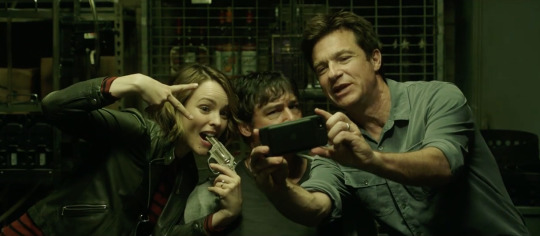
37. Game Night (John Francis Daley and Jonathan Goldstein)- It gets a little tidy and full circle for my taste, but this movie has some great laughs while being a good example of a film that nails both the characters' "want" and the characters' "need." Rachel McAdams is winning, and Jesse Plemons steals all of his scenes.
Game Night also has way more of a filmic identity than one might expect, since it doubles as a sort of Fincher parody. Besides Cliff Martinez's insistent electronic score and some CGI-for-no-reason establishing shots, Daley and Goldstein borrow the auteur's desaturated palette, locked-down camera, and narrow light range. There's even an elaborate one-r. The visuals elevated a premise that had the potential to be really dopey.
36. First Man (Damien Chazzelle)- I think this is exactly the movie Chazelle wanted to make, but, to match my expectations or his filmography, it's not quite good enough. Cool to the touch, though anything else would be antithetical to who Armstrong was. In the shape of suspense, but with an outcome that is obviously never in doubt. Flipping to the IMAX ratio the second the crew docks onto the moon is a cool trick, but it's as innovative as things get.
The cast is game. Gosling's fastidious brooding resists any of his Movie Star charm but still holds every scene, and the framing of Armstrong's motivation works very well. Foy's reading of "a bunch of boys" is about to become a t-shirt. Kyle Chandler and Jason Clarke and the suddenly mature Patrick Fugit all get their moments. The final scene places the film into the Chazelle tradition of people whose calling is greater than even their most transcendent relationships, and a protest sequence is a welcome break from the eraser-streaked perfectionism.
I'm sorry that I wanted Apollo 13 instead of a hipper Apollo 13.
35. Spider-Man: Into the Spider-Verse (Bob Perischetti, Peter Ramsey, Rodney Rothman)- Within the course of one year, we got two possible solutions for the "problem" of inspiring but self-serious origin stories. At the beginning of the year, Black Panther mastered the form and presented it so solidly that it couldn't be argued against. Spider-Man: Into the Spider-Verse goes the other way, so impressionistic that the final sequence is people flying through abstract shapes and colors, so irreverent that a character cuts someone off mid-sentence as he says, "With great power comes..." Though I would have trouble explaining the film, all of the dimensional comings-and-goings make sense in the moment, and it's easily the funniest Marvel movie ever made.
Maybe purposefully, it is overstuffed though. Six different iterations of Spider-Man is enough to juggle; I definitely didn't need a cadre of villains that was even less defined. I have to admit, even though I couldn't tell you what to cut, I was exhausted by the end, even if I was huffing and puffing fresh air.
34. Boy Erased (Joel Edgerton)- Many characters do bad things in this movie, but they're people trying to help and doing their best, justifying the pain that they're causing. This is a film that easily could have been drawn in caricature, and it never is. It does, however, draw the characters as fairly as they deserve, so the Joel Edgerton gay conversion therapist does wear bad ties and pronounce some words incorrectly. The Russell Crowe character, especially in the powerhouse final scene, is more complex and real, at least if I'm to judge by my own father, who has disturbingly similar moral authority and power moves k thx bai.
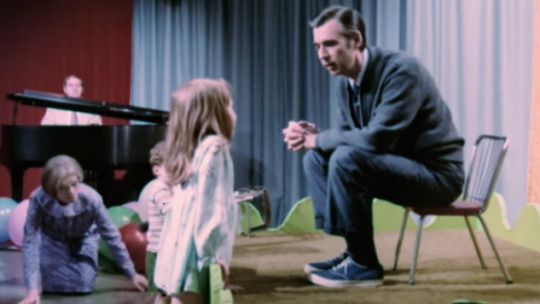
33. Won’t You Be My Neighbor? (Morgan Neville)- This one is more cohesive than 30 Feet From Stardom, but these Morgan Neville docs are sometimes too slick for their own good. If you've never made the "jerking-off motion" with your hand, then you'll be tested when he asks his subjects to close their eyes and imagine someone special to them.
That's not to say that the nearly pornographic reverence of Fred Rogers is not deserved or effective. And one of the most daring notes of the film is the suggestion that, in our hostile times, Rogers's message might not have stuck. The jabs at Trump aren't overplayed, but the president is sort of a pall over the entire film. When Rogers says, "The most essential things in life are invisible," it's hard not to imagine the person on our TV daily who is the antithesis of that idea.
32. Hearts Beat Loud (Brett Haley)- This is a heartwarming movie that ends on a high note with solid music. (Important because, if the music that the father and daughter made had been bad, the whole thing would have fallen apart.) Occasionally, it falls into that ensemble problem of "Good news: We got Ted Danson. Bad news: We have to find something for him to do." And it's a weird sideways ad for Spotify. But if I gave Begin Again three stars, then I have to kick this Once-core entry up to three-and-a-half.
If I may, though, I would like to analyze a recommendation that Offerman's record store owner makes to Collette's character. Since she's buying Dig Me Out by Sleater-Kinney, he puts her on to Animal Collective's Merriweather Post Pavilion, an album she has not heard of. Which is absurd. Forget that Animal Collective should not be recommended to any woman ever. Any person who knows Sleater-Kinney also knows Animal Collective. She would have heard of them if only because they would be a bad match for someone who likes Sleater-Kinney. But here he is all like, "Check out 'My Girls'--killer song." You're going to recommend the lead single, fam? You're not even going to go out on a limb and push "Bluish"? No wonder your store is shutting down if you're pushing free folk/art-punk onto riot grrls.
31. Western (Valesta Grisebach)- While I was watching Western, I can't say I was having too much fun. It seemed like an adequate story told in a patient, austere way. But in the days since then, I haven't been able to get it out of my head. The way that Grisebach gets so much out of non-professional actors, the way that each character seems to exist not so much as a person but as a totem for something like aggression or labor or exploitation or occupation. Like few other movies--though Beau Travail comes to mind--it's a portrait of masculinity that seems really resigned about its conclusions. 30. American Animals (Bart Layton)- I worry about the potential Boondock Saints effect of this movie: Do I want to be in the same number as the college dorm crew attracted to it only for its style? Is it only style? I don't think it adds up to much ultimately.
But it does have style, and it's way too fun of a caper flick to resist. It presents an interesting bridge in Bart Layton's career, from non-fiction that is a bit too fictional to fiction that is a bit too factual. The segments with the real people involved in the heist serve as decisive punctuation to the florid sentences of the narrative. I also appreciated that the film didn't dwell too much on the trial, since we know exactly where the boys faltered and what evidence did them in.
29. The Land of Steady Habits (Nicole Holofcener)- I loved the rich characterization of the first half, which resists hand-holding as it plops the viewer into a post-divorce setting that is familiar but specific. The film bounces off into tangents from there, some of which are great, but Edie Falco seems to draw the short straw. There are three actors on the poster--weird-voiced Ben Mendelsohn, Thomas Mann, and Falco--but her character is left undeveloped, a bit unfairly, as the proceedings favor the men. The film is still another ground-rule double for Holofcener, a filmmaker who gives the impression that she has no idea what a ground-rule double is.

28. Private Life (Tamara Jenkins)- I don't know anything about Tamara Jenkins's personal life, but there's no way that the details and emotion of the central couple's infertility don't come from her own pain. That frustration and obsession take center stage, and we get filled in with the rest of the details patiently as the film goes on. I don't think we even know what Giamatti's character does for a living until forty-five minutes in, and that's okay. The movie cares more about the supporting characters than I did, but I appreciated the lived-in realism of an apartment with books filling up the fireplace.
27. Flower (Max Winkler)- Although I didn't believe Zoey Deutch as a seventeen-year-old, I was impressed by this script, which moves slowly until it doesn't. I guess "Flower" is good branding since there doesn't appear to be a movie called that already, but I kind of wish this had just been called "Erica." It builds that character carefully, plants her in an impossible situation, then unleashes hell upon her.
An advantage of a movie with teenage characters is that they don't necessarily have to make the most logical decision in a given moment, so even when these characters are being dumb, they're being true to themselves. As the most prominent Zoey Deutch stockholder in North America, I actually thought about bumping this up an extra half-star.
26. Leave No Trace (Debra Granik)- Leave No Trace is partly about how existing outside of society can be as much of a contrivance as buying in, but the way the movie delivers that message is less ham-fisted than my description due to the intense performances at the center. Ben Foster, uncharacteristically restrained here, reportedly worked with Debra Granik to excise 40% of his dialogue, and that choice speaks volumes about the trust the film has for the audience in limiting the exposition.
The only thing holding me back was how exclusively internal the father-daughter story is. Unlike Granik's Winter's Bone, which functions as both a (similarly compassionate) coming-of-age story and a race-against-the-clock thriller, Leave No Trace is tracking only emotional growth. Will and Tom aren't headed anywhere in particular, which is part of the survival-versus-living point. But, you know, get you a Debra Granik movie that can do both.
25. Eighth Grade (Bo Burnham)- Socially terrifying when it isn't being effortlessly funny. Sometimes the protagonist is downright frustrating, which the film doesn't shy away from, but the vulnerability of Elsie Fisher's performance grounds everything around it. Besides nailing adult condescension, Burnham's script works because the big social disaster is always averted until it suddenly isn't, and that's when the moment hits the hardest. Somewhere in the back of my mind though, I kept thinking that perceptive realism is easy to do if that's your only goal. To quote the kids: "Some shade."
I spent most of the movie thanking God that YouTube channels didn't exist when I was thirteen.
24. Three Identical Strangers (Tim Wardle)- I'll be the millionth person to write "truth is stranger than fiction" with regard to this movie. And sometimes having no idea where a movie will go is enough. 23. Green Book (Peter Farrelly)- When a dramatic director makes a comedy, it often feels self-conscious and overt. I'm thinking about Von Trier's The Boss of It All, in which the technique is more important than any audience joy or release. Or Michael Haneke explaining tirelessly why he thinks Happy End is "actually a comedy." Unsurprisingly, the results work a lot better when a comedy director of twenty years decides to go more serious. He knows what audiences want, he already understands how to wring tension out of each scene, and all he needs is the right subject.
The last item is where Green Book suffers. In the end, this is still a movie in which a White guy learns not to be racist. The first third, there seemingly to insist that Tony is the main character, is shaggy. I would wager the men don't get into the car inside of forty minutes. But once we're on the tour? Man, is this a crowd pleaser. The men's respect for each other grows gracefully, and the film's proud sentimentality powers its best moments as they fly by at a clipped pace. I had given up on Farrelly after Hall Pass, which felt amateurish, so a work of such professionally manicured (manufactured?) emotion was a shock.
On a different note, are any of you interested in a thousand words on Linda Cardellini's posture?
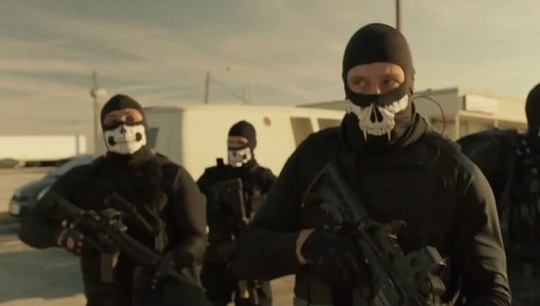
22. Den of Thieves (Christian Gudegast)- Despite the February release date, a director with no track record, and the most #basic studio lead there is, Den of Thieves is a caper film as sprawling as it is humane. Even Potato-face Butler is perfect for his role.
I watched the unrated version, which should be called the "depressing version," since I know exactly what was cut. (Hint: The wordless scene of Butler's jilted family ignoring him when he sees them in the grocery store, not anything from the shoot-out.) There's a spot where I would end the movie, and it's way before the Keyser Soze epilogue, but this was a welcome surprise for me. The movie seems to find its star in O'Shea Jackson, Jr. as it goes, and I completely agree. Many more like this please.
21. The Front Runner (Jason Reitman)- Reitman starts with a complicated oner that cranes up and down, zooms in and out of new characters, and times itself perfectly to catch snatches of conversations about "how can you even lay this much cable?" And in all of its Altman-esque indulgence, it's kind of the movie in a nutshell. Something simple--a scene shot with one take--commenting on how damned hard it is. What seems like a straightforward thesis moves at a breakneck pace with a game ensemble until you realize that it was all more complicated than it seemed.
Hugh Jackman has the challenge of playing someone essentially unknowable, but he has an amazing moment in the first third. On the chartered boat called Monkey Business--such a bad look, dude--Gary Hart is composed and dignified until a woman we don't see* sits down across from him, and his whole affect changes. His guard drops, and he seems absorbed by her, giggly. We can't hear what he's saying, but he's asking her about herself and joking about himself. Both or one or neither of those personalities is the real guy. The Front Runner is a movie about a tragic Great Man, and they're always described as if they can't help themselves, as if they're fighting their demons until the magic moment when they aren't. Jackman made that magic real for me when Hart's personality fell out.
20. The Ballad of Buster Scruggs (Joel Coen and Ethan Coen)- Patently uneven and bizarrely sequenced, The Ballad of Buster Scruggs doesn't stack up to the Coens' major works--though it demands another viewing. I did think, in all of its bleak absurdism, that it belongs in their neighborhood. To me, there's a dichotomy that most of the brothers' films trace. We're all doomed, but the force that does us in is sometimes fate (A Serious Man, Inside Llewyn Davis, The Hudsucker Proxy, No Country for Old Men) and sometimes the stupidity of other people (The Big Lebowski, Blood Simple, Burn After Reading, Miller's Crossing). This new movie seems to start with the latter, waver sometimes in the more interesting middle stories when Zoe Kazan and Tom Waits break my heart, then end up at the former. Tracking such a thing in miniature can be really instructive.
19. The Tale (Jennifer Fox)- If you can look past Common's goofy voice and the more afterschool special aspects of this movie, then you can realize that it should actually, as disturbing as it is, be an afterschool special. It spins its wheels sometimes, but the questions that this movie asks about memory and abuse are invaluable. Presenting a downright shocking portrayal of grooming and secrecy, it avoids easy answers and over-sympathizing with the protagonist all the way through. (Especially notable because the character is "Jennifer Fox," and the director is Jennifer Fox.)
Laura Dern remains Laura Dern, but I loved Jason Ritter in this. Exactly because he has been in a hundred failed sitcoms, he is terrifying here as a devilish knock-off of the type of guy approachable enough to be on TV.
18. Paddington 2 (Paul King)- At first, during the extended introduction, I was worried that Paddington 2 was falling prey to the curse of the sequel: more, not better. But as each family member pays off what we learned about him or her in the introduction during a sprightly train setpiece that owes more than a little to Keaton, I realized that I shouldn't have doubted the Paddington empathy machine. This one carries over the humor and sweetness but goes even harder on the pathos in its attempt to convince us to have good manners and care about the people around us. I'm not sure any other movie this year hit me harder than when the Browns don't show up for their weekly meeting at the jail.
Hugh Grant, an actor who always seems to be having fun, has never seemed as if he is having more fun.

17. Set It Up (Claire Scanlon)- I guess I believe in true love now.
16. Blindspotting (Carlos Lopez Estrada)- The stylized climax is going to be polarizing, but I thought it was a heightened, artful moment whose seeds had been sown throughout. The film meanders, but its angles on subjects like gentrification and probation and identity show tenderness and openness, and Estrada's visual energy recalls early Spike Lee or Jarmusch or Aronofsky. It's worth seeing if only for its fresh sense of place.
The two leads play off each other especially well. If Daveed Diggs is the fourth lead or whatever of Hamilton, then I guess I finally have to see it.
15. Incredibles 2 (Brad Bird)- Incredibles 2 is a good example of a sequel rhyming with the original in a way that doesn’t feel like a retread. Accidentally topical in its subtext about just rule of law, the film hits upon some of Brad Bird’s ideas of exceptionalism and hope for the future while being slightly more cogent in that messaging than the original. (Slightly. The villain problem is still there. If superheroes are already illegal, then why employ and promote them at all if your goal is to make them even more illegal?)
This entry is a bit more overstuffed, less timeless, and less funny than the original. There’s nothing on the level of “Honey, where is my super suit?” which I still say to my wife fourteen years later. But the fight choreography and the textural animation take advantage of the gap in between films. The Paar family dynamic is altered only slightly, but it’s enough to re-invent the proceedings. Violet has more confidence in herself, Dash is more in control of his powers, and it’s the, yes, thicc Elastigirl who is working solo this time. Especially in the opening sequence, we see how each character’s skills complement the others’. If Finding Dory is the bar for “sequels to Pixar movies that didn’t need sequels,” then Incredibles 2 leaps over that bar.
14. Chappaquiddick (John Curran)- "We need to tell the truth. Or at least our version of it."
After the Kennedy Curse claimed JFK Jr., it seemed as if the culture reached a saturation point with Kennedy coverage. Aside from the occasional "Look who's dating Taylor Swift," we gave them their space. Who would have thought that twenty years later would be the perfect time to dust off the coldest case in the dossier?
See, now that we're having a national conversation about who gets the breaks, there's a little bit of extra weight lent to a scene of Ted Kennedy waiting for a sheriff he summoned as he drafts a statement at that absent sheriff's desk. A sheriff who then helps Kennedy to escape through a backdoor lest he answer any untoward question about his manslaughter. The film is delivered with an even pitch--especially the Jason Clarke performance that could have been overdone--but it makes no mistake about its real subject: privilege.
The attempts to keep Kennedy safe become more brazen as the film goes on, and each dodged consequence--getting Teddy's driver's license renewed on the low, for example--is balanced by Ed Helms's desperate performance as a voice of integrity. In all of the best tragedies, we know what's going to happen in the end. All along, the Kennedy Curse was that they are not like the rest of us.
13. Love, Simon (Greg Berlanti)- Can we all agree that an anonymous gossip web site for a high school is a bad idea? And that, though the film doesn't pursue this angle, the vice principal is the one maintaining it?
This propulsive, observant, and witty movie is an outright pleasure from beginning to end. Hocking spitballs at its PG-13 rating, its greatest strengths are having the courage to get dark and having the wisdom to give every supporting character his or her own moment.
0 notes
Link
Artists: Calla Henkel and Max Pitegoff
Venue: The Downer, Berlin
Date: June 18 – August 1, 2020
Click here to view slideshow
Full gallery of images, press release and link available after the jump.
Images:
Images courtesy of The Downer, Berlin
Press Release:
I’ve known Calla and Max for a decade now. I’ve seen the spaces that their work endeavored to create. I have happily (occasionally begrudgingly) been a part of some of their exhibitions and projects during the course of this time. I once read from receipts pictured in a series of photographs after having installed them in front of a live audience; I performed in a play they wrote and directed about an in-fighting but enterprising band of squatters who run a ramen restaurant out of an apartment they share; I helped assemble banquettes in their theater, hung and painted backdrops, operated the video camera, mopped floors, and built architectural models. I’ve sold their work to collectors and donated my own paintings to their benefit auctions. Our lives are closely connected and likely will be for their remainder. This show has nothing to do with our shared history, so I will refrain from dredging up too much more of it after this paragraph. But unlike any other thus far, this show is charged with a particular energy for me. Calla and Max had a big influence on the circumstances that brought me to Berlin, Also, it was through their initiative that the Downer began.
In my eyes, the core of Calla and Max’s work is the idea of community and shared experience. It examines the ways in which these ideas can be deployed against authority or serve to reinforce it. For as long as I’ve known them, and longer, their work has brought people together. Using friends as models, actors, performers and collaborators, they have created and fostered communities. As the complexities and personalities of those communities bristled against one another, they have likewise served as mediators, confidants and — conversely — the objects of disparagement. They have founded and operated bars, venues and theaters, with each space comprising some ratio of these component parts. Their first was a ‘bar’ in their shared studio at Cooper Union — which was more of a sculpture that encouraged people to get together and have a beer. Then followed Times Bar in Berlin, founded in collaboration with Lindsay Lawson, New Theater and TV Bar, which just reopened after a few months of Covid-19 provoked shutdown (and which you should go visit). Calla and Max’s practice is, on one hand, institutional critique and, on the other, embodiment of the institution.
The series of photos that I installed and read from in 2013 pictures artists sorting through their receipts, presumably in preparation to submit them to the tax office. The photographs don’t picture the artists themselves, just out of focus glimpses of them in front of or behind receipts piled on kitchen and cafe tables. Each piece was given the instructive title of the artist’s first name, the city (always Berlin) and a period of time (i.e Spring 2013). In a simple gesture the gut-leadening feeling of dealing with anything related to taxes is communicated. For artists and artworkers in particular, who exist in an industry where passion for art is often exploited to extract unpaid labor, the quarterly conundrum of what is and isn’t a warranted write off is evoked. Was that book for enjoyment or research? Was that dinner business or pleasure? Should I have been paid for this or was I volunteering? Where do fun and labor coincide and how can they be properly distinguished when friendships blur into professional relationships? This anxiety isn’t really related to taxes — that question is quickly answered with, “write off as much as you can get away with” — but these photos indicate a deeper existential uneasiness about the ways in which we are evaluated. Moreover, they say something about the ways in which we evaluate our own lives and work, and the relationships that often straddle the blurry boundary between them.
My definition of a scene would be: a recognizable movement in which the participants’ activities — as artists, performers, personalities, whatever, really — draw them into the same chapter of collective imagination, compounding the significance and reach of their ideas. Scenes have driven the advancement of art for a few hundred years and have been allowed to more or less write their own histories. The overlapping scenes that Calla and Max have cultivated over the past decade provided fodder for their own artistic work, as well as giving inspiration and a platform to their myriad members. Relationships extend beyond Berlin and the physical spaces they have helmed, situating Calla and Max’s work within a growing, networked alliance of artists — many of them also involved in organizing project spaces or artist run galleries.
I’ve met lots of people through Calla and Max and I imagine a lot of people reading this feel the same way. Sometimes being introduced felt uncanny, as if the scene was manifesting its connections after it had already made them algorithmically. Other times I’ve been surprised to meet someone at New Theater or TV Bar who was so unknown to me that my first conversations with them felt revelatory, despite the fact that, superficially, our lives bore so much similarity.
The way that people get to know one another and end up influencing each other is something that has been parodied in Calla and Max’s plays. Many of them open on a group that has ended up together more or less by chance. “Farming in Europe” featured a cadre of restaurant workers — a textbook example of multifaceted, diversely motivated collaboration. A gang of dejected vacationers populated “News, Crime, Sports,” a play that was set on an unmoored and un-captained cruise ship. The ragtag band of squatters who sell ramen out of their home in “Apartment” seemed to have fallen in with one another out of sheer necessity. In these arenas, characters quibble over ideological differences and willingness to contribute to a collective cause. They ridicule each other for their shortcomings, pontificate about the meaning of life and agonize over how to solve their problems. They also kind of take care of one another. Their haphazard convergence nearly always ends in haphazard goodbyes, but they usually manage to have a revelation or two along the way.
A scene, of course, is also an element of theater. The artists that have coalesced around Calla and Max’s organizing efforts feed one scene that cannibalizes itself for inspiration in others. The characters in their plays are — like all works of fiction — mash-ups of real personalities. Some ended up playing versions of themselves. Others didn’t have to look far for someone to imitate — they were probably sitting in the first three rows. Casts of mostly untrained actors, who were performing mostly for their friends, took scripts into their own hands, whether intentionally or not, returning them to the collective through misremembered lines, unscripted giggles and embellishments that kept the balance of who’s-using-who in a kind of limbo. This cultivated antiprofessionalism has become a hallmark of Calla and Max’s projects, giving them both a liveliness and an easily accessed escape hatch. If you don’t take something too seriously no great disappointment can come from it.
I would venture that we exist in a moment that is anxiously and unrecoverably disconnected from earlier utopian artistic scenes. One of the reasons is that everything is so connected already. There are increasingly fewer insights and ideas to share offline as the internet swallows and aggregates, and we increasingly substitute our collective consumption for shared experience. Does a group of people who have seen the same meme constitute a scene — not really, right? Interestingly, Calla and Max almost never use the events at their spaces as documentary subjects. Occasionally they will exhibit used, purpose-built furniture or show photos that picture dirty tabletops or half full glasses. But it’s hard to track down images of their friends socializing or even of their plays being performed. When they do ask friends and collaborators to pose, it’s almost always in a quasi-fictional role — in costume, or at least with ample stage direction. Beyond headshots, this same feeling is conveyed in their series of photographs of friends’ apartments made-up for AirBnB. These depict idealistically polished, yet inherently blemished living spaces that are uncomfortably braced for evaluation. Real spaces fictionalized for someone else to imagine themselves in. Documenting something or someone being candidly themselves is resolutely, almost inherently, barred from Calla and Max’s vocabulary. As if to acknowledge that we live in the moment of the curated feed, where everything is staged and everybody is acting as their own director, giving stage direction to the leading character of their own auto-drama.
When not focusing on fictions, their photographs often focus on the liminal — the absent or the accumulation that starts to make itself heard from the wings. The ostensible subjects of their photos are usually only tangentially related to a larger subject, like a newspaper, an empty cocktail glass or a receipt. In a large series of photographs of apartment viewings from different cities, the subjects were the desolate interior landscapes that serve as a backdrop for hopeful projection. Shot in black and white and printed in a darkroom — decidedly the opposite method of image making employed by the real estate industry — these photos occasionally feature glimpses of other visitors to the viewings. Mostly they feature the product of an emptying out, volume exchanged for capital. In a funny way, they are almost antithetical to the AirBnB stagings — one attempts to conjure domesticity with no props, and the other attempts to hide the props to allow potential guests to conjure domesticity in someone else’s home. Neither strategy is as helpful as you would hope.
A third, more recent series of photographs that also relate to living spaces pictures vignettes of the residence of the US Ambassador to Germany, which is a private home that changes occupancy with each diplomatic appointment. The photos were lit using theater lights from New Theater, giving the scenes an amber melodrama that heightens the antiquated domestic setting, questioning the relevance of the pomp of this classic American excess. At the same time, diplomacy gestures towards a version of interpersonal interaction that yields more than just a social life. Are the machinations, backstabbing, and insider trading of the artworld all that different?
Having sought places to stage performances, serve drinks or host conversations for over a decade, it’s no surprise that Calla and Max’s work also obsesses over real estate. What good is an eager audience without a space to host them? And as art and performance have increasingly dematerialized themselves to fit onto laptop and iPhone screens, Calla and Max have doubled down on their belief in physical space as paramount in provoking thought and fostering friendships. The question of art’s influence on real estate has been scrutinized by artists for 50 years or more, but this link is calcifying as art is more and more frequently deployed in an effort to gentrify. Artists face the paradoxical sociopolitical inner-turmoil of occupying both sides: they are often economically and ideologically linked to those who face displacement and, conversely, dependent on and symbolically linked to those profiting from the displacing. A big, and seemingly growing share of art collectors are making fortunes in real estate. As an artist, striving for patronage and solidarity presents contradictions without easy resolutions. In a sense, this horrible dilemma could be seen as another, deeper motivating factor in Calla and Max’s practice — to create a space that masquerades as something more functional than it actually is. A ragtag gang of artists play-acting the operations of a legitimate business. Theirs is an institution that aims to welcome as many as possible and preside over none of them. Art should aim to do the same.
Patrick Armstrong
Link: Calla Henkel and Max Pitegoff at The Downer
from Contemporary Art Daily https://bit.ly/3fBOZk6
0 notes
Text
Fear and the learning faith
Sometimes things are getting better even when they don’t feel like they are getting better. Old ways are changing, new ways are coming and the mind obsesses about specific moments, or people, or groups of people and change doesn’t feel like change because the mind fixates for a time.
No, I’m not speaking about a person working through recovery. Though I could as an “addict” learns to use different ways and means to live life (without compulsive use of a process or substance). As a person learns to live differently, the focusing job of the prefrontal cortex sometimes makes things feel worse (like when I first learned how to snowboard).
And no, I’m not talking about the United States’ current political situation (probably every political situation)...though I might very well be. For example, for all the violence rhetoric, the statistics show long term declines in a number of areas that show that things are actually getting better but are by no means perfect. Yet, the political mind fixates on a tragedy...for a time...until another tragedy or event (some people even seem to manipulate this understanding of people with Machiavellian precision). Like our minds, we have limited ability to focus our attention and the focusing that occurs through media often makes things feel terrible...like an anxious, angry or shame-filled negative self talk. And it doesn’t feel good.
Today, I’m talking now about the church. The church is dying in the West many say. Just look at attendance figures. In Europe, the church is a relic of history for the most part. Many lament these changes and some get vocal in detrimental ways (insert most any Pat Robertson comment here) as a means to try to explain why their once thriving audience is becoming geriatric and fading. In some ways, this behavior seems like the addict that doubles down back into the addiction rather than face the pain of finding a different way to live. Those addicts usually die first.
There is a convergence happening across the sciences that is linking physics, neuroscience, psychology and sociology (among others) that describes the ways in which a complex system organizes. This convergence is showing how an emergent property of these complex systems helps the system to regulate itself. That’s the theory of what a mind is in a person but that a “mind” is also present in a society or a group. When these complex systems break down, it is because there has been impaired integration of the parts (e.g. the parts don’t talk to each other with a dose of humility) such that harmony turns toward dissonance. Think of a jazz band or orchestra that don’t play well together. The system turns toward rigidity or chaos when integration is impaired. Think of an addict struggling when one part of his or her mind overrides all of the other parts. Hell, think of most any church leadership council meeting (from what I hear).
But, like the addict recovering, the brain is rewiring to form new ways of learning to live. New neural pathways get written as old pathways slowly get pruned away...until the addict finds that the new normal is much more beneficial than the old normal. It’s a learning process.
I think this learning process is also happenening with our politics...and it’s painful.
And then I think of the church. Many in society view the institution as irrelevant. Many view it as a place where more shame and burden will be heaped on an individual already struggling with toxic shame, guilt and fear. And, in many instances these people are right...churches have abused. Narcissistic leaders have wounded and have not acted with Christ-like integrity. The church has abandoned many. Both the Right and Left cherry pick their Bible verses to decry those leaders that do not fit their views and label others “stupid” or “morons” or the anti-Christ (both sides). The church speaks with such hypocrisy about love and grace and then ignores or condemns or gossips through prayer chains about certain people’s hurts, orientations or actions. In many cases, church has become a toxic bastion of rigid thinking, not different than an addict rigidly sticking to his or her old way of thinking. In many ways, declining church participation is likely the sociological equivalent of the pruning of useless neural pathways as a person learns, not some indication that the devil is winning some cosmic battle.
Learning is messy. Grace is messy. Integration happens when the parts link together and share information with humility.
In some ways I think Christ catalyzed the new, emerging property of what makes a person and a society well. His message of grace, forgiveness and reconciliation to God, others and self is at the core of the integration process. The narrative of death and resurrection can be seen as the story that helps me to internalize a new way of life, one free from toxic guilt, shame and fear and one that breaks the rigidity and chaos of my own mind and heart to create a harmony within myself, connected to God and others. But it’s messy, it’s always messy. Nothing is ever perfect but it is generally directional...that’s how we learn...
So, if God is the loving parent, doesn’t a loving parent want his child to grow, internalizing his love for them, so that the child can become an adult that loves like the Father? That’s the story right? But this church thing has become quite antithetical to that goal for a great many. People are adapting accordingly and the mind of society is rewiring...and that may not be such a bad thing.
“Oh my God, people are leaving in droves.” Good! Perhaps it’s time for a restructuring toward that which is actually useful for these people. It’s time to adapt and rewire the mind and heart of the Church, getting to the principles of the matter. And, this rewiring is starting to take place. That’s why it hurts, that’s why it’s messy.
That’s why there is grace, so we can learn.
A few points in my mind for this learning process to continue.
- as Paul reinterpreted portions of the Old Testament in the light of the truth of Christ as Messiah, so to should we reinterpret the Bible in the light of God’s truths as they become evident through the sciences. Integrating our faith with science is the key and I do not think they are as antagonist as most best selling book publishers would suggest.
- we are finding that healthy relationship networks are vital to healthy change, focus on creating tools and opportunities for effecting this change as is specific to people’s pain points.
- learn from other traditions. Use the notion of integration as linkage with humility when interacting with others. Evolve. Find the best of both and create a remix.
- leverage scientific findings in teachings that corroborate viewpoints. Also speak openly about scientific teachings that counter viewpoints so you will be seen to have authenticity in pursuit of reality, not just some rigid, cherry picking Bible verse quoter that condemns (usually to hell) others for different views.
- focus on integration. Work toward harmony within yourself, your organization, your society. Promote connection with humility.
- love your neighbor as yourself. Look at both sides of the equation...too often people have loved others more than themselves and have used bible verses to support their covert narcissism.
Just a few thoughts for the journey.
0 notes
Text
Interview: Taylor Deupree
Since its inception in 1997, experimental music label 12k has been winning over listeners with its distinctive brand of quiet minimalism, employing a radically pared-down musical and visual language to present novel amalgams of the digital and the organic. With seminal releases by Ryuichi Sakamoto, Christopher Willits, Stephan Mathieu, Stephen Vitiello, and Shuttle358 over its 20-year lifespan, 12k has established itself as one of the most recognizable outposts for modern ambient and experimental electronic music today. Label head and musician Taylor Deupree — who has himself contributed some of the label’s most stunning releases under his own name — initially conceived of the label more as philosophical than commercial project. (12k’s website still cites twelve principles upon which 12k was founded, which include such maxims as, “Treat your audience as they are: intelligent, passionate lovers of art and sound,” and “Stay quiet, stay small.”) As the label’s stature grew, Deupree says that he felt a responsibility to 12k artists to make the venture financially sustainable, all the while holding fast to the label’s core principles — a high-wire act that continues to this day. Deupree has managed the label’s roster, release schedule, package design, publicity, social media, shipping, and often audio mastering by himself since the beginning, working out of his home studio in rural upstate New York. I visited him there to discuss the initial inspiration, day-to-day operation, and future outlook for a small art label such as 12k, as it collides with current trends in music discovery, promotion, streaming, and social media. --- What’s the primary function that you see a small label such as 12k serving today? I think the label still serves an important curatorial and communal function. Often, reviews of individual records on 12k will talk about the label as a whole, not just the album in question. I owe a lot to the listeners and writers who understand that context, and have been strengthening that idea of the curatorial aspect of this community, which is one of the few things that we have left. You have bigger labels that can offer tour support, all this stuff, which I can’t do. But the history of the label, and the followers, and the people who say, “Oh, it’s on 12k so I’ll probably like it” ― that means a lot. You can offer a new artist a sense of community, as well as a digital network and a press network. I do feel a responsibility to the artists to at least sell something. People know they’re not making a lot of money on the label, but hopefully they’re at least getting some kind of “street cred” that’ll help them get a gig or help them get to a bigger label. I don’t keep my artists on any type of exclusive basis. I’m a tiny label. If they can go from here to something bigger, that’s great. They all deserve it. I know what my limits are. What do you look for in other artists as the label’s curator? To what degree do you favor a resonance with the label’s existing aesthetic versus a singular artistic point of view? I look for both. I always look back at the history of 12k and there are kinds of clumps of styles, trends. And it’s all based around what I’m into at that moment. It’s always evolving, but I tend to get people who fit whatever I’m currently into. But I really like it when I get a demo that’s a shot out of left field and I can see how it would work on the label. The most recent example of that is Gareth Dickson. He’s one of my favorite 12k artists, but he’s a singer-songwriter. He just does these beautiful, melancholic songs with acoustic guitar and voice. If you played me that 15 years ago and said, “This is what you’re going to be releasing,” I’d be like, “Get out of here, there’s no way I’m putting a guitarist and a vocalist on 12k.” But things change. I was so excited to put it out. And people might listen to it and say, “Wait, this is on 12k?” But then maybe they’ll see how it makes sense. It’s quiet, it’s mellow, it’s minimalist and honest, there’s a lot of reverb. It might not have worked back when I started when the label, when everything was really synthetic. I never even thought I’d release an album that didn’t have any synths on it. But once you do that kind of thing, you’ve opened up a new avenue. And yet I’d like to think that there’s something that binds it all together. La Niña Junco by FEDERICO DURAND How do you manage to find time to run the label amongst you other professional roles as mastering engineer and musician? Doing it by myself for 20 years, I’ve definitely got a routine down. I know how to do it. There are all these little things to get a release ready that I can squeeze in between other projects: working on the art, getting the mastering done, writing the press release. Or at night, sitting on the couch, I can populate the website or get promotional mailings out. Those kind of things I can do any hour of the night. Then once something’s out, it’s running to the post office to ship orders and stuff like that. It’s a lot of small, little jobs. You can do one thing here and one thing there. As opposed to mastering, where you need a big chunk of time to do the album, or writing music, where you really want to take a few hours and get lost in it. The label’s a little more business-y. Maybe the danger there is that you might get too comfortable. You’ve been doing it so long, you fall into these habits, for better or for worse. So I’ll always try to bounce ideas off of label-mates. “No, that kind of packaging is not that good. Let’s try something like this.” It’s good to have those outside ideas and feedback. A lot of times I’ve actually thought, “Should I get more people? Should I make it a bigger company and get an office somewhere?” I’ve always not done that ― which is probably a good thing because it may have tanked by now. For the benefit of the artists, 12k seems much bigger than it is. The aura around the label has grown to be much greater than just me in the basement just packing up orders. And that’s been by design since day one. It’s not like I’m putting anything false out there. I’m just to trying to create this sense of community, or this curatorial sense — this little ecosphere of happening — and hope it gets out there. And it’s been a long time. Half of it must be just how many years it’s been running. But it’s gotten out there and it’s bigger than just one guy running it in his spare time, which is great. I think if you were going to start a label today, you’d really have to do something different. Releasing a CD and downloads on Bandcamp — I mean, anyone can do it — but with today’s flooded landscape, I don’t know if that would be enough. Years ago, it was easy. Now, it’s like you have to do something radical. You’re quite active on a variety of social media platforms personally. Do you feel that’s helped build the label’s visibility as well? I think it’s one of the only ways that I can do it. I’m very conscious that no matter what forum I’m posting on, it always comes back to me and, by extension, the label. People have always put my name and the label name in the same sentence. So everything I say, even if it’s on my own personal Twitter feed, is a direct reflection on the label — and, as a result, a direct reflection on the artists on the label. So everything I do, I do under the 12k umbrella — what I’m talking about reflects what the label’s about. Whether it’s about a piece of gear or whatever, hopefully it adds up to all this cool stuff that makes the label what it is. I could make accounts or post in different places under strictly separate identities and try to keep me separate from the label, but I don’t. I purposely just make it all into one thing and it’s all part of what the label’s about. The label’s about this kind of sound or that kind of sound. Or this synth. Or studio acoustics or photography. It’s just this whole world that I kind of live in — for better or worse. And that probably couldn’t be possible without social media. For a label whose aesthetics have come to be associated with the quiet, insular, and slow, it’s interesting that you’ve embraced social media, with its seemingly antithetical values. Twitter and social media are great for getting the word out, but you can’t forget to go outside and turn the computer off, embrace some of these things that the label’s about. It’s like we’re pulling all of what’s out there into the music, using social media to get the word out, and then you can go back out there and enjoy it. One of my favorite Brian Eno Oblique Strategies is: “Go outside and shut the door.” The more these iPhones and social media are running our lives, the more we want to get away from it. Trying to explain that to my teenager is not very easy. But I want to get away from it, especially the screen. My own music has become less and less reliant on the computer lately. Somi by TAYLOR DEUPREE You started 12k in 1997. What would be your advice to someone thinking about starting their own label in 2017? Is there still room for a small experimental label to survive in today’s climate? If you asked me a year ago, I’d probably have a different answer than I do today. I think if you were going to start a label today, you’d really have to do something different. Releasing a CD and downloads on Bandcamp — I mean, anyone can do it — but with today’s flooded landscape, I don’t know if that would be enough. Years ago, it was easy. Now, it’s like you have to do something radical. Just in the last year, things have gotten even harder then they were. What’s happened in the last year? Well, a few things. First, with streaming taking over, you’re seeing digital sales drop. Less people are buying music from iTunes. I think people are listening just as much — or more than they ever were — but more and more people are streaming and paying less and less for their music. All of us who ran small labels 10 years ago — when MP3s were just becoming the norm — we were worried about the end of the physical product. In the end, I don’t think digital sales actually hurt CDs sales all that much, although the pirating really hurt, especially for the small labels. Now, it’s the streaming. I have friends considering ending their labels that they’ve been running for a long time because CDs just aren’t selling. Streaming has taken over as a really legal form of piracy. And then in January 2016, the U.S. Postal Service decided to raise their prices on international shipping. From that day forward, intentional label sales have just spiked down. Back in 2012 or so it used to cost $1.56 to send one CD to a mail-order customer in Europe or Japan. Then in 2013 they announced a price increase, suddenly quadrupling the price to $6.55. Fortunately, no one minded and it didn’t seem to be a big problem. In January 2016 they raised their prices again; it now costs $13 to send a CD. Vinyl records are $22. The cost of shipping is now as much as the cost of the product. That seemed to be the line that people are no longer willing to pay. People look at that and look at a download and say, “I’ll just take the download.” The aura around the label has grown to be much greater than just me in the basement just packing up orders. And that’s been by design since day one. It’s not like I’m putting anything false out there. I’m just to trying to create this sense of community, or this curatorial sense — this little ecosphere of happening — and hope it gets out there. How do you buy your music personally? I don’t stream music, but I don’t buy CDs either. I buy almost all my music from iTunes. Here I am making CDs, but I’m part of the problem. The thing is, though, that every artist you talk to would always prefer a physical release. It’s been talked to death, but it’s nice to have that CD — to sell at shows or to show to your friends and family. But it’s getting harder and harder to sell them. I’m getting by, thankfully, from devoted listeners who’ve been following the label for 19 years. You actually have a lot people buying records who just listen to the downloads — they just like having the physical object, and that’s great. Reading the liner notes and holding the record. Putting the needle down, and listening to it. Standing up and flipping it over. Maybe it’s an old way of thinking and old guys like me think it’s a lost joy. Have you considered any alternate release formats that fulfill this craving for the physical object? Yeah. One thing I’m doing for my solo album [Somi, 2017], as a guinea pig for upcoming 12k releases, is this small format that’s a 20-page hardcover, color book. It’s a little bigger than CD size, and comes with the CD in it. Really nicely made and printed. In this case, it’s photography of mine that goes with the music. I mean, it’s not groundbreaking [laughs] — a million people have done books and CDs, and it’s expensive to make. But if it works, it may just replace regular CDs completely for future releases. Each artist would be responsible for filling 20 pages. Lyrics, writing, photographs, scores — something visual. The label’s always been really visual, so this would be an extension of that. Through all the ups and downs, do you feel that you’ve achieved what you originally set out to do with 12k? Oh yeah, it’s exceeded my expectations. But the goal was always to keep it going. The goal will never be finished. Some people tell me I should be proud just to be still doing it now in this environment after so many years. But the main thing it’s given me, in a personal way, is all my friends. All my best friends around the world are people I met through the label — really good friends who I confide in — from demos I received years ago. So it’s just created this sense of family. And to be able to go to Japan with a group of guys and do a little label tour — the audience is really excited and we get to hang out for a week in another country — that’s pretty special. I trust that my listeners are intelligent and love supporting music and will be there — and they have been. But I’ve also learned in recent years that we have no idea what’s around the corner. As new generations come up who haven’t heard of you, or don’t know what iTunes is, or don’t know what a CD is, then it’s up to me to adapt. Up to this point the adaption has been slow, and at some point it may get extreme. I don’t think the label would ever just stop, though. I’m going to just weather on doing what I do. http://j.mp/2phGC5Z
0 notes